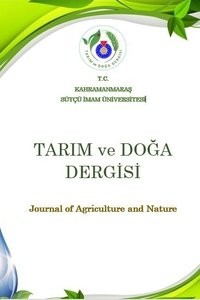Türkiye Orjinli Yulaf Genotiplerinin Basit Dizi Tekrarları (SSR) Markörleriyle Karakterizasyonu
Yulaf, Avena sativa, Avena byzantina, Moleküler karakterizasyon, SSR
Molecular Characterization of Turkish Oat Genotypes Using Simple Sequence Repeats (SSR) Markers
Oat, Avena sativa, Avena byzantina, Molecular characterization, SSR,
___
- Aslan E 2015. Farklı Gen Bankalarından Elde Edilen Yulaf Hatlarının SSR (Basit Dizi Tekrarları) Markörleriyle Karekterizasyonu. KSÜ Fen Bilimleri Enstitüsü Tarımsal Biyoteknoloji Anabilim Dalı 52s.
- Bennett P 2000. Microsatellites. Journal of Clinical Pathology, MolecularPathology, 53: 177-183.
- Boczkowska M, Tarczyk E 2013. Genetic diversity among Polish landraces of common oat (Avena sativa L.). Genet Resour Crop Ev 60: 2157–2169.
- Dice LR 1945. Measures of the Amount of Ecologic Association between Species. Ecology, 26: 297-302.
- Dumlupınar Z 2010. Türkiye Orijinli Yerel Yulaf Genotiplerinin Avenin Proteinleri ile Morfolojik, Fenolojik ve Agronomik Özellikler Yönünden Karakterizasyonu. KSÜ Fen Bilimleri Enstitüsü Tarla Bitkileri Anabilim Dalı, Doktora Tezi, 112 s.
- Dumlupinar Z, Brown R, Campbell R, Jellen EN, Anderson J,
- Bonman JM, Carson M, Chao S, Obert D, Jackson E 2016a. The Art of Attrition: Development of Robust Oat Microsatellites. Plant Breeding. doi: 10.1111/pbr.12362
- Dumlupınar Z, Jellen EN, Bonman M, Jackson EW 2016b. Genetic Diversity and Crown Rust Resistance of Oat Landraces from Various Locations throughout Turkey. Turkish Journal of Agriculture and Forestry, Doi: 10.3906/tar-1509-43
- Ellegren H, Moore S, Robinson N, Byrne K, Ward W, Sheldon BC 1997. Microsatellite evolution-a reciprocal study of repeat lengths at homologous loci in cattle and sheep. Molecular Biology and Evolution, 14(8): 854-860.
- Fu YB, Peterson GW, Williams D, Richards KW, Fetch JM 2005. Patterns of AFLP variation in a core subset of cultivated hexaploid oat germplasm. Theor Appl Genet 111: 530–539.
- Hoffmann LA 1995. World Production and Use of Oats. “Alınmıştır The Oat Crop-Production and Utilization (ed) Welch, R.W.,Chapman and Hall, London, UK, 34-61.
- Kün E 1988. Serin İklim Tahılları. Ankara Üniversitesi Ziraat Fakültesi Yayınları, No: 1032. Ders Kitabı No: 299, Ankara, 216 s.
- Liu BH 1997. Statistical genomics: Linkage, mapping, and QTL analysis. CRC Press LLC, Boca Raton New York, USA, 648 s.
- Montilla-Bascon G, Sanchez-Martin J, Rispail N, Rubiales D, Mur L, Langdon T, Griffiths I, Howarth C, Prats E 2013. Genetic diversity and population structure among oat cultivars and landraces. Plant Mol Biol Rep 31: 1305–1314.
- Newell M A, Cook D, Tinker NA, Jannink JL 2011. Population structure and linkage disequilibrium in oat (Avena sativa L.): implications for genome-wide association studies. Theor Appl Genet 122: 623–632.
- O’Donoughue LS, Souza E, Tanksley SD, Sorrells ME 1994. Relationships among North-American oat cultivars based on restriction-fragment-length-polymorphisms. Crop Sci 34: 1251–1258.
- Oliver RE, Obert DE, Hu G, Bonman JM, O’Leary-Jepsen E, Jackson EW 2010. Development of oat-based markers from barley and wheat microsatellites. Genome, 53(6): 458-471.
- Oliver RE, Lazo GR, Lutz JD, Rubenfield MJ, Tinker NA, Anderson JM, Wisniewski Morehead NH, Adhikary D, Jellen EN, Maughan PJ, …, Guedira GLB 2011. Model SNP development for complex genomes based on hexaploid oat using high-throughput 454 sequencing technology. BMC Genomics 12: 77.
- Peterson DM, Wesenberg DM, Burrup DE, Erickson CA 2005. Relationships among agronomic traits and grain composition in oat genotypes grown in different environments. Crop Science, 45: 1249-1255.
- Rohlf FJ 2005. NTSYS-pc: Numerical Taxonomy and Multivariate Analysis SystemVersion2.2. Setauket, Exeter Publishing, New York, USA.
- Weber JL, May PE 1989. Abundant class of human DNA polymorphisms which can be typed using the polymerase chain reaction. American Journal Human Genetics. 44: 388–396.
- Başlangıç: 1997
- Yayıncı: Kahramanmaraş Sütçü İmam Üniv.
Sosyal Medyanın Tüketicilerin Gıda Ürünleri Satın Alma Davranışına Etkisi
Saros Körfezi Gorgon (Anthozoa, Octocorallia, Holaxonia) Topluluklarının Demografik Yapıları
Primula vulgaris Yaprak Ekstraktının Antioksidan ve Sitotoksik Özelliklerinin Değerlendirilmesi
Selim DEMİR, İbrahim TURAN, Rezzan ALİYAZICIOĞLU, Yüksel ALİYAZICIOĞLU
Doğu Akdeniz Bölgesinde Bulunan Sulak Alanlarda Oluşan Toprakların Kil Minerali Özellikleri
Ahu Alev ABACI BAYAN, Kadir YILMAZ
Mehmet ARSLAN, Nurcan ERBİL, Taygun TİMOÇİN, Rima ÇELİK, Mehmet Tahir HÜSUNET, Hasan Basri İLA
Türkiye Orjinli Yulaf Genotiplerinin Basit Dizi Tekrarları (SSR) Markörleriyle Karakterizasyonu
Ali TEKİN, Erdem ASLAN, Sevgi HEREK, Tevrican DOKUYUCU, Hasan GEZGİNÇ, Halil TEKEREK, Ziya DUMLUPINAR, Aydın AKKAYA
Neşe ERTUGAY, Emine MALKOÇ, Nihal KOCAKAPLAN
Echinops phaeocephalus (Asteraceae) Türünün Antimikrobiyal ve Antioksidan Aktivitesi
Elit İvesi Koyunlarında Meme Tipinin ve Bazı Çevre Faktörlerinin Süt Verimine Etkisi
